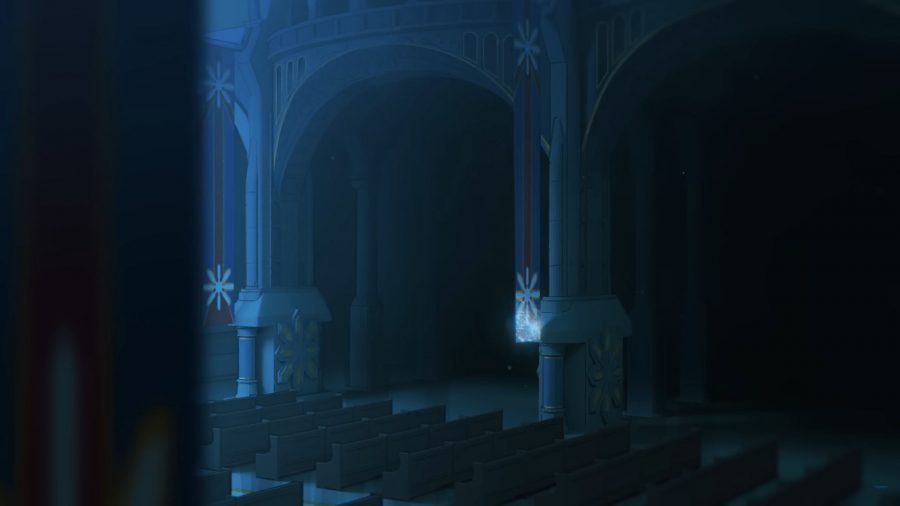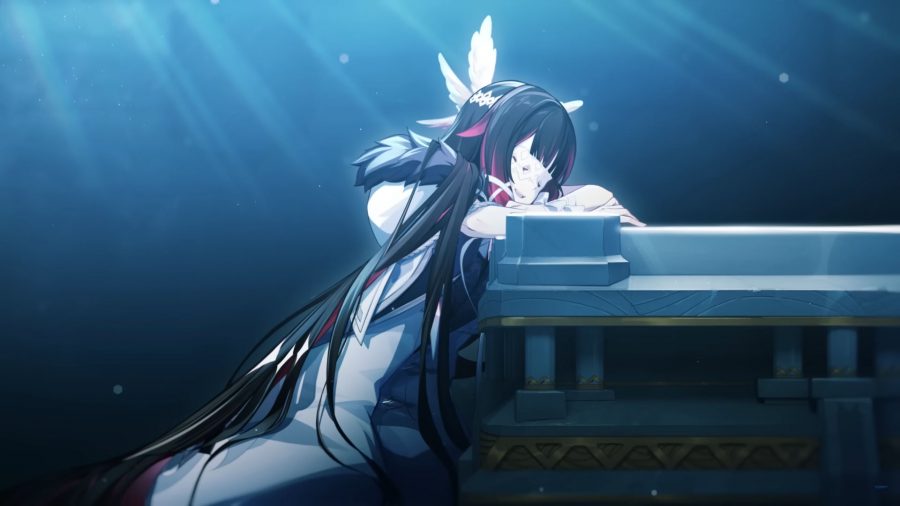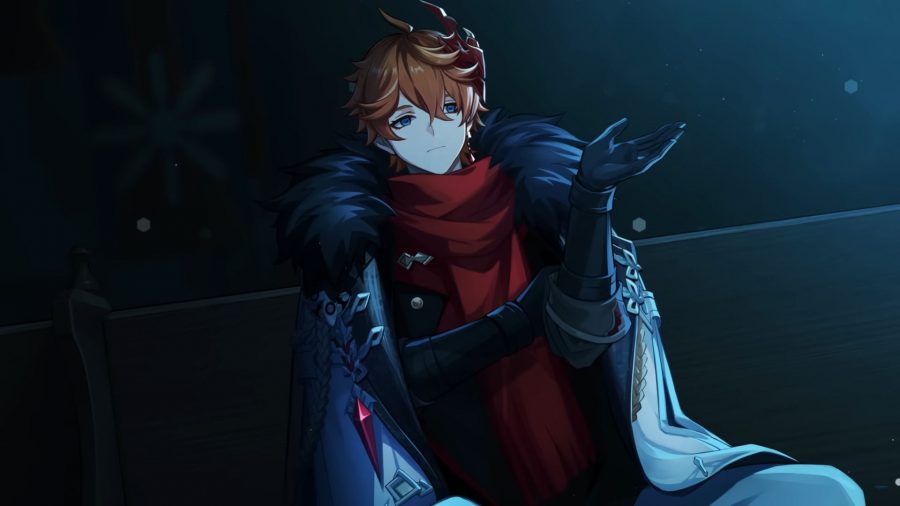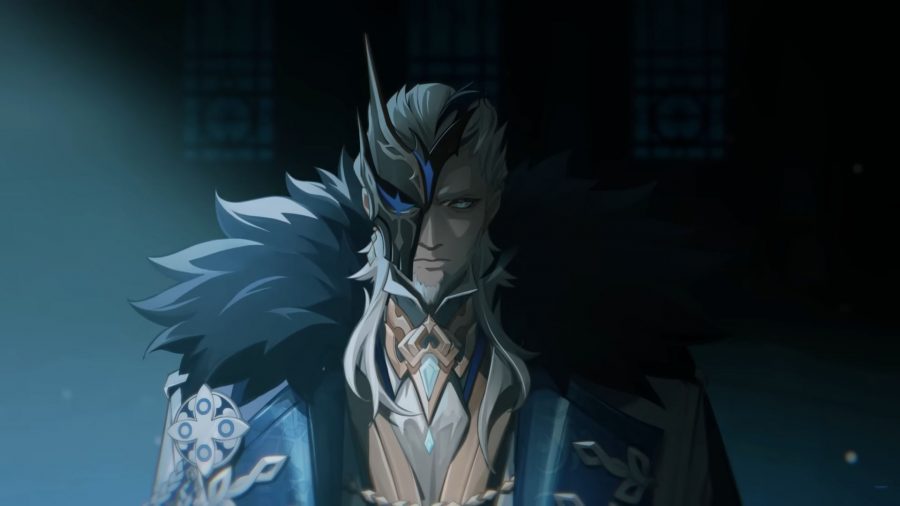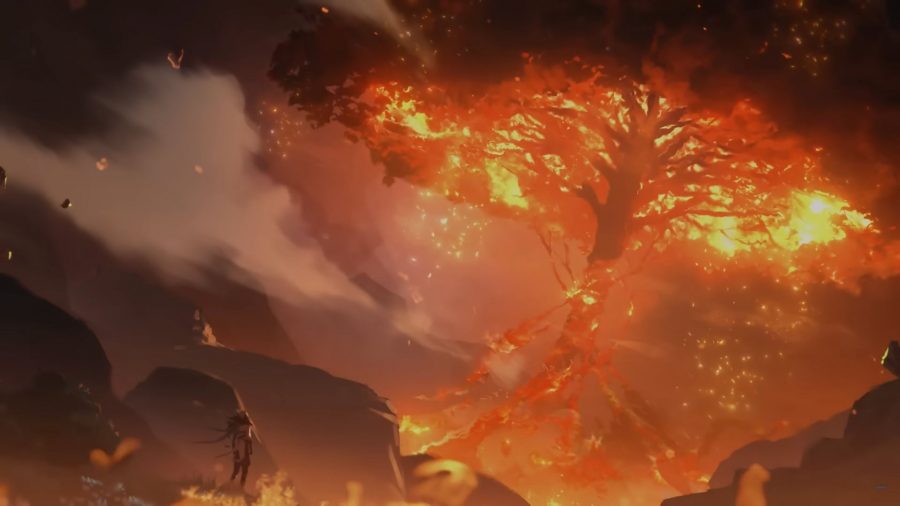The Genshin Impact Harbinger trailer, A Winter Night’s Lazzo, has been out for a while now, and we’ve been obsessing over it since we first saw that hellfire butterfly flutter against the wind. Hoyoverse is known for its intense world-building and deep lore, but nobody was expecting this bombshell to drop – not only revealing all of the Harbingers we’re yet to see in-game for the first time but also slipping in so many significant world-building details and hints of what’s to come.
Of course, as the resident Genshin obsessor, I’ve taken it upon myself to go through the Genshin Impact Harbinger trailer frame by frame, dissecting everything I can, in order to bring you this A Winter Night’s Lazzo explained piece. I’ve pawed through the manga, riffled through item descriptions, researched 16th-century plays, and stared at wall textures until my eyes hurt, all to try and make sense of this stunning piece of lore.
Keep in mind, that this analysis is based on my knowledge of Genshin’s world (both within and outside of the game), personal opinions, and research. In short, I’m just an over-enthusiastic Genshin fan with too much power, and the lore is so steep there’s always a chance that I’ll miss something – be sure to hit us up on Twitter or Facebook if there’s anything important that we didn’t clock! Anyway, buckle up, this is gonna be one wild ride.
Genshin Fatui Harbinger trailer title – what does ‘A Winter Night’s Lazzo’ mean?
To start off, let’s take a look at the title of the trailer – ‘A Winter Night’s Lazzo’. The ‘winter’ part is pretty self-explanatory, with the scene being set in Snezhnaya, home of the Harbingers. Snezhnaya is under the rule of the mysterious cryo archon, the Tsaritsa, and the land is known to be plagued by perpetual winter storms.

As for it being ‘a winter’s night’, I believe this signifies the end of something. Idioms often refer to old age as the ‘evening’ of one’s life, and with the overall focus on the trailer revolving around La Signora’s death, she’s reached the ‘night’ of hers. Also, after night, there’s dawn – and, under the direction of the Tsaritsa, the Harbinger’s goal is to ‘burn away the old world’ and bring in a new way of life. This suggests that they may see La Signora’s death as the end of a chapter, a sacrifice required before moving to a new world without the rule of Celestia.
Then we get to the odd word that many of you may not be familiar with – lazzo. Lazzo, in its direct translation, is Italian for ‘joke’. A lazzo (plural lazzi) is an improvised comic dialogue or action in the Commedia Dell’arte. The Commedia Dell’arte was an early form of professional theatre, originally from Italy, which was popular across Europe between the 16th and 18th centuries. Tying in with this, each of the Harbingers has a name and codename inspired by the typical characters of the Commedia Dell’arte. Therefore, this whole thing may be seen as a type of performance, where everyone we see is playing a specific role.
Though ‘lazzo’ may mean ‘joke’, it also has potential roots in the word ‘lacci’, which means ‘connecting link’, referring to comic interludes performed by the character Arlecchino (Harlequin) – funnily enough, the name of one of our Harbinger pals. Lazzi were an important resource used by commedia actors, that consisted of verbal asides on current political and literary topics, manifestations of terror, or pratfalls and other acrobatics.
So, in this case, La Signora’s death can both be seen as a manifestation of terror and a current political topic. A manifestation of terror, due to the violent events of her death, and a political topic, as her work claiming the gnosis of other Archons is highly politically motivated, and an important part of the Tsaritsa’s plan.
As such, this ‘lazzo’ can be seen as a link between two different parts of the overall play. The first part, in which the Harbingers and the rest of the Fatui set up their foundations, spreading their reach across the nations, leading to La Signora taking both Venti‘s and Zhongli’s gnosis, and helping Scaramouche acquire Raiden’s. Then the second part, in which the Tsaritsa and her Harbingers use the power they’ve already acquired to tighten their grip over the other nations, claim more of those shiny chess pieces, and, eventually, overthrow Celestia itself as the Tsaritsa has long intended.
Aside from the direct ties to the Commedia Dell’arte, I also feel that the title ‘A Winter Night’s Lazzo’ is pretty reminiscent of the works of William Shakespeare. To be specific, it sounds to me like a reflection of ‘A Winter’s Tale’. There’s some contention over whether A Winter’s Tale should be grouped with Shakespeare’s comedies or late romances, due to its first three acts consisting of intense psychological drama, whereas its last two acts are more comic, and eventually lead to a happy ending.
I feel this perfectly reflects the highs and lows of the Tsaritsa’s tale and her goals for the future, with Childe saying ‘Her Royal Highness the Tsaritsa is actually a gentle soul. Too gentle, in fact, and that’s why she had to harden herself. Likewise, she declared war against the whole world only because she dreams of peace’. There are also further ties between Shakespeare and the title, considering the fact that his works also feature a form of ‘lazzo’, though in his works they’re known as ‘jigs’.
There are plenty of other ways we could interpret the meaning of the title and the word ‘lazzo’, but let’s stick with this theory for now, as I’ve already gone on long enough about the title alone!
Genshin Impact Fatui Harbinger trailer scene by scene
Now, let’s get into the scene-by-scene breakdown of the trailer itself, and what I think each part means. For this part, I’ll separate the analysis into three sections – scene I, with the butterfly and the chessboard, scene II, inside the building where the Harbingers meet over Signora’s coffin, and, finally, the intriguing scene III, featuring Il Dottore, Sumeru, and Collei.
Scene I
The first scene of the trailer follows one of Signora’s Hellfire butterflies, flying against the snow. The butterfly is struggling in the harsh weather but perseveres in order to get home, signifying La Signora’s sense of duty even in death – to the Tsaritsa, her ‘family’, and the land she fought for in life.
Next, we see a chess board, with multiple pieces knocked over. This is also where we see our first glimpse of Pierro, the first of the Harbingers and director of the group. Initially, he appears to be playing alone, moving the black pieces manually. However, the white pieces move independently, with a white glow shimmering over them as they do.
This white glow and the mist that surrounds the moving pieces look like a cryo aura. When combined with the cryo particles in the air, I believe that this proves Pierro is not playing alone – he’s in fact playing against the Tsaritsa herself, with her either controlling the pieces remotely or from just out of shot.
It’s clear from the offset that this chess board represents more than just a simple game – it’s symbolic of the strategies and the battle they’re fighting. The black pieces represent the Fatui, whereas the white pieces represent their opposition – us (as the Traveler), our allies, and the other archons that have not yet fallen. The fallen pieces represent those lost in the battle so far. We can also see the gnosis the Harbingers have taken so far, now on the Fatui side of the board – Morax’s geo gnosis, shown glowing gold, and Barbatos’ anemo gnosis, shown glowing blue.
The white knight piece knocks over the black pawn, then Signora’s Hellfire butterfly lands on the fallen piece, implying that it represents her. I believe that the white knight piece represents the Traveler as, all although it was Raiden who landed the final blow on La Signora, we agreed to fight her before the throne, knowing that the loser would be executed. Additionally, the other archons are represented by king and queen pieces, so it’s likely that Raiden/Ei would be a king or queen piece, too. Therefore, we’re led to wonder – who is the opposing knight? Is it our long-lost twin?
The dialogue for this scene comes from Pierro himself. He states that ‘the sages think themselves to be all-knowing, but we, alone, are wise in the virtue of these acts of folly’. These sages may be referring to those of either Khaenri’ah, or Sumeru, both of which the members of the Harbingers have seen conflict with. In reference to ‘those acts of folly’, we circle back to the meaning of ‘Fatui’ being ‘fools’. By dubbing themselves fools, they highlight that they’re wise to the folly of believing you know everything, setting themselves apart from the ‘all-knowing’ sages.
This ties into Dainsleif’s line in the chapter preview, where he states ‘in the city of scholars there is a push for folly, yet the god of wisdom makes no argument against it’, which may be referring, once again, to those sages and scholars who strive towards the impossible goal of being able to know everything.
After this, Pierro states ‘in this war, not even a single pawn may be spared’. This could be referring to La Signora, who may have been a simple pawn, but her sacrifice was not in vain, and her movement played into the wider game beyond the chessboard. It could also be referring to the significance of every piece on the board – regardless of how weak or insignificant an opposing pawn may look, they could still sabotage the Fatui’s plan. As such, they need to be wary of the opposition, and ‘not spare’ anyone who may get in the way.
He finishes by saying ‘because on this chessboard, “checkmate” is not where the game ends’, implying both that this game doesn’t follow the usual rules of chess, and the current events are but a fraction of the bigger picture. They may have lost this battle in some sense, but it was a move towards winning the overall war.
Scene II
Here, we move to the inside of a building. It’s difficult to discern what type of place this is at first, but with the architecture, pews, and stained glass windows I believe it’s some kind of church, temple, or synagogue – which makes sense as we pan to Signora’s coffin. The building is cast in blues, greys, and blacks, reflecting the physical and metaphorical cold of the land, with a snowstorm billowing outside. It lacks the jovial songs and worship seen in Mondstadt’s chapel but instead reflects a sense of cold reverence and respect befitting the nation.
As the camera reveals the surroundings, we see a banner with Snezhnaya’s snowflake motif hanging on the wall. Frost creeps up the fabric, crackling and turning it brittle, and cryo particles glitter in the air. This, once again, suggests that the Tsaritsa herself is in some way present – still remaining hidden, but there to mourn her lost child.
The video description states ‘no one knows how long it has been since all the Fatui Harbingers last gathered’, and we get our first glimpse of them together here. They’re spread out, standing at a great distance from each other, aligning with Childe’s insinuation that, though they are in a way like a family, the Harbingers don’t always get along. However, the fact that they gathered together to mourn the death of La Signora despite their differences shows the significance of her loss.
We see a character hunched over Signora’s coffin, singing Signora’s song (the one you hear in the background of the Signora weekly boss battle, when she’s in her cryo form). This is Columbina, the third Harbinger. We know from Childe’s voice lines that she’s a little unhinged (that may be an understatement), which ties in with the somewhat menacing sound of her soft voice, and her unsettling little smile which seems out of place considering the circumstances.
We don’t have much information on the relationship between her and Signora, but we do know that Signora loved to sing – so Columbina singing Signora’s song could be seen as either in honour of her death or mocking her. Columbina looks childlike and innocent, yet she’s one of the highest ranking Harbingers and the only one who Childe fears. She wears lace over her eyes instead of a mask, suggesting a filtering of reality, through which she only allows herself to see parts of the truth.
From here, Pulcinella takes the lead, with the camera angled up to show respect to him despite his short stature. Though he is the fourth of the Harbingers, he clearly exudes authority, which is enhanced by his older appearance. He begins by saying ‘we are gathered here today to remember our dear comrade. In honour of her sacrifice, all work should halt for half a day as the nation mourns her passing’.
The suggestion of the entire nation coming to a halt in the wake of La Signora’s passing, even for just half a day, highlights the high stature of the Harbingers in Snezhnaya, as a national holiday is often reserved for events relating to monarchs or important public figures.
In response, Pantalone questions ‘merely half a day? People say the Northland Bank’s true currencies are blood and tears, but Mayor, even speaking as a banker, that sounds a little unconscionable’. Pantalone is known to be the head of the Northland Bank, a Snezhnayan business that spans many nations, including that in Liyue. He’s adorned in expensive jewellery that highlights his theorised status as the wealthiest person in Teyvat.
His eyes are closed, face the picture of serenity, and his voice somewhat teasing, as though he’s unphased by Signora’s death and was perhaps even expecting it. It’s also interesting to note that Pantalone refers to Pulcinella as ‘Mayor’, which suggests that he is, in fact, a figure of authority – be that within the Harbingers, or as a literal Mayor presiding over Snezhnaya.
Next, Arleccino steps forward. She’s adorned with blood-red jewels that look somewhat reminiscent of La Signora’s Hellfire butterflies, and she has unique red exes in her eyes – a physical trait I don’t believe we’ve seen before. Her voice is fierce as she says ‘Rosalyne died in a foreign land, but you heartless businessmen and dignitaries, always with a convenient excuse to remain in the comfort of your homeland, you couldn’t hope to understand. So why don’t you keep your mouths shut? We don’t want to make the children cry.’
After her words, the camera pans to Childe, which seems almost comedic – both due to his code name, and the fact that he’s the youngest of the Harbingers. However, her reference to the children is actually likely due to her running the House of Hearth orphanage in Snezhnaya, where children are adopted into the Fatui. This could either suggest that the orphanage is, in fact, in the same building as them and therefore the children are within earshot – or, perhaps, Arleccino is mocking the rest of the Harbingers, suggesting that they’re akin to the children she raises.
Additionally, Arleccino’s combative words and her use of La Signora’s real name, Rosalyne, suggests a closeness between the two, or at the very least a sense of kinship or common ground. It also pits her against the more scheming, business-focused members of the group, highlighting the fractious nature of the relationship between the Harbingers despite a common goal.
Returning to Childe, we see him sitting back, distancing himself from the conflict. He’s wearing his iconic red scarf, which many fans have theorised was a gift from his family. Regardless of its origin, the vibrancy and size of the scarf represent his individuality and further enhances his separation from the rest of the Harbingers.
Despite his ever-combative nature, he scolds ‘hey, c’mon now, even I don’t think this is the right time or place for a fight’, waving his hand nonchalantly. Childe has made it clear in the past that he didn’t like La Signora, and the betrayal he felt following her backhanded deal with Zhongli, the man he believed to be his friend, clearly fed into this further. However, despite his flaws, Childe is seen to be quite loyal to his own set of morals, and as such he likely feels the need to refrain from conflict both out of respect for La Signora and the Tsaritsa.
In response to the squabble, or perhaps Childe’s words specifically, Sandrone comes into the frame. She giggles softly, muttering ‘utterly risible’ (meaning funny or ridiculous). Sandrone is seen to be sitting on the hand of a large automaton, its arms bearing marks similar to those seen on the Ruin Guards and similar robots. Aside from those two words, she remains quiet, suggesting that she feels above the situation.
Next up is Il Capitano. He’s tall and intimidating, his face obscured by a mask and his voice deep and commanding. He has an air of regality and nobility as he speaks, condemning the fact that La Signora’s ‘methods tarnished her honour’, likely referring to how she let her temper, pride, and tenacity overcome her, especially towards the end.
However, he still mourns her sacrifice as a ‘great pity’, and vows that ‘her loss shall not hinder [their] progress’. He then turns to Il Dottore and asks ‘what of Scaramouche and the gnosis from Inazuma?’, drawing our attention to the Balladeer’s absence.
This also guides us to our first proper look at Il Dottore, whose design is drastically altered from his appearances in the manga. He looks more mature, refined, and in control than his chaotic, wild-eyed former self, and he shakes a vial of liquid similar to those he wears in his earrings. He cryptically states ‘conventional wisdom holds that Divine Knowledge cannot be rationally comprehended’, potentially suggesting that, as an original prototype puppet of Ei’s, obtaining the gnosis he was originally intended to act as a vessel for may have awoken something within him, with which he’s now grappling to understand.
Dottore then says ‘after conquering the Divine Gaze, he will make his next move’. This man just loves speaking in riddles, doesn’t he? Here, the Divine Gaze he’s referring to could be interpreted in multiple ways. Firstly, visions could be seen as the divine gaze, as they’re a divine gift given to heroes after the gods deem them worthy, and gaze and vision are both related to sight. We’ve also heard (unconfirmed) whispers that Scaramouche will, someday, be a playable character with a vision separate from his delusion, so it could indeed be related to Scaramouche gaining his own vision and fighting to conquer it, though I feel that’s a little off the mark.
My other theory is related to a discussion between Yae Miko and Raiden in the Plane of Euthymia, where Yae says ‘what your people need from you is not your promises. They want your attention, your divine gaze’. Though I don’t think this line is directly related, the specific word choice is intriguing and may hint that it’s actually a sense of divine power or responsibility that Scaramouche is now attempting to conquer, or perhaps the attention of the archons or Celestia itself.
Our final Harbinger reveal comes next, with the camera panning up from some snazzy shoes all the way to a fierce face, showing Pierro in full. Half of his face is covered in a mask, with the other half bathed in shadow, making his unique eye stand out. And – wait, what’s that? A star-shaped pupil? So far, the only people we know with those piercing eyes and star-shaped pupils are Genshin Impact’s Kaeya, Genshin Impact’s Dainsleif, and NPC Halfdan, who are all Khaenri’ahn. We all know Hoyo wouldn’t slip something like that in without intent, so I think it’s pretty safe to say that he’s from Khaenri’ah too.
Pierro’s right eye is covered – the same one that Kaeya wears an eyepatch over. This is a complete shot in the dark, but it got me thinking. Kaeya claims that he inherited his eyepatch from his grandfather, a pirate, though it’s later revealed that his eye is actually scarred, thanks to Diluc injuring him during their battle after Diluc’s father Crepus’ death. However, I can’t help but wonder. Both Pierro and Kaeya originate from Khaenri’ah, have their right eyes covered, are associated with the cryo element in some way, and wear clothes of a nearly identical colour scheme. Could they, in some way, be related? Is Pierro in fact Kaeya’s real father or grandfather?
Anyway, back to the video – Pierro walks towards the other Harbingers, stating ‘it’s time to end tonight’s foolish theatrics’, informing them they ‘have no captive audience’, playing into the title of this being a ‘lazzo’ of some kind, which renders each of the Harbingers as an actor in the Commedia Dell’arte. It also suggests that, thus far, this is all performative.
Pierro then launches into a bit of a monologue, saying ‘let every worthy sacrifice be carved in ice, and with this nation endure for all time. In the name of Her Majesty, the Tsaritsa, we will seize authority from the gods… Absolute Peace. Such is the gift from the Tsaritsa, such is Her Majesty’s benevolence. Now you rest in this coffin, encased in layer upon layer of ice. But, Rosalyne, I promise you… Your final resting place will be the entirety of the “Old World”’
Wow, that’s a biggun. So, let’s start from the top. The metaphor of carving every worthy sacrifice in ice doesn’t necessarily mean Pierro plans on popping out a chisel and getting into the art of ice sculpting – moreso, this refers to the foundations of Snezhnaya, a land built on ice, bearing the memories of those sacrificed for the cause. The people fighting for the Tsaritsa’s cause are carving and shaping Snezhnaya, and will always be a part of it, long after death – and that, of course, includes La Signora.
Next, we hear the tenderness and devotion Pierro holds in his voice as he speaks his archon’s name, as well as the repetition of what Childe states about the Tsaritsa – that she seeks to seize authority from the gods in pursuit of absolute peace, and that this is the gift from her – it’s her benevolence. While striving for peace by causing conflict may sound counterintuitive, the lore points to the underlying narrative that the reason the Tsaritsa believes absolute peace must come at the cost of Celestial power isn’t necessarily because she thinks by her seizing power, she’ll be able to fix the world’s problems.
Instead, it’s more to do with her, and the other archon’s, disenchantment with Celestia after witnessing the Cataclysm 500 years ago and seeing how it affected their people. I believe the Tsaritsa’s mission – and, in turn, the Harbinger’s – isn’t necessarily about gaining power in the end. It’s about taking power away from someone else.
Finally, Pierro addresses La Signora, laying her to rest beneath a bed of ice, before promising her that her final resting place will be the entirety of the ‘Old World’. The Old World refers to the current state of Teyvat, under the rule of Celestia and the gods.
This line also reflects the item description for the shivada jade gemstone, a quote from the Tsaritsa: ‘Sorry… to also have you shoulder the grievances of the world. Since you could endure my bitter cold, you must have the desire to burn? Then, burn away the old world for me.’ I personally believe that this was actually the Tsaritsa addressing La Signora, finding common ground between them as two women who have suffered heartbreak and undergone a fierce metamorphosis as a result.
From here, we see all the Harbingers gathered around Signora’s coffin, with Pierro standing at the end. We still don’t know the rankings of all the Harbingers, so I tried to work out whether the formation of the group gives us any hints. Unfortunately, it doesn’t seem to line up perfectly with the numbers we know for certain so far, so I’m still working on that one. If you’re interested, keep an eye out for my upcoming piece taking a closer look at the Harbingers – I may have some more answers by then.
The snowstorm outside picks up, encasing a building with architecture reminiscent of a Russian Kremlin or Monastery in ice. We’re unsure if this is the building the Harbingers had just met in, or if it’s a separate tomb. Either way, it’s frozen in time, fortified by sharp shards of ice erupting from the ground. We see Signora’s coffin, also encased in ice, and watch as that poor little Hellfire butterfly rests on its edge and burns up entirely, the embers blown away to represent Signora’s final rest.
It’s likely the only one strong enough to cause a blizzard capable of encasing Signora’s coffin and tomb in thick shards of ice would be the cryo archon herself. As such, this could be seen as the Tsaritsa mourning her loss, suggesting that she does, indeed, care about the Harbingers as though they were her children, building giant monuments to them in their memory. Alternatively, it could be taken as a statement, showing the other Harbingers and the people of Snezhnaya how significant her work in obtaining the gnosis was.
Scene III
In the final section of the A Winter Night’s Lazzo trailer, we cut to a black screen following the dramatic crescendo of La Signora’s entombment. Columbina says, in a soft, light voice ‘I must say, you’re looking very young today, Doctor’, to which Il Dottore replies admonishingly, stating she knows he doesn’t take that as a compliment. Columbina ignores him, going on to ask, ‘so, where’s the segment in the prime of his life, then?’
From this and the following scene, we can infer that Dottore is in fact split into multiple sections (two at least, maybe more), which somehow appear to exist simultaneously, yet also on different timelines. It’s unclear whether these different versions are clones, fragments of the original Dottore, or something else entirely, but he seems to have the ability to see what the different versions of himself are doing.
From the manga, we already know he’s capable of transferring consciousness from human to machine, as he did with his underling, Krupp. Also, with Columbina saying ‘you look very young today’, it implies that his age fluctuates, meaning time is non-linear to him, and that there’s a specific version of himself that he considers more ‘prime’ than others.
Dottore states that the prime segment is ‘busy with a little experiment in blasphemy’, flashing to a shot of Dottore standing before a burning tree. This appears to be the main tree at the heart of Sumeru, in which the main city is built. As the tree is still currently intact, we can presume that this segment of Dottore is actually somewhere in the future. Dottore actually attended Sumeru Akademiya before he joined the Fatui, but was shunned by his teachers and peers due to his dangerous experiments and goals to create enhanced humans that could ‘surpass even the gods’ – a concept considered blasphemous in and of itself.
Suddenly, Collei jumps awake, gasping. The video description notes that she has ‘not had dreams for a long time’ but she ‘saw strange visions during her midday nap’. But what does she have to do with Dottore? Well, as mentioned before – though Dottore is yet to appear in-game, he’s made some significant appearances throughout the manga, and so has Collei. Collei was born sickly, with her parents reluctantly handing her over to Barnabas, a Sumeru seer who promised to help her.
Unfortunately, Barnabas was in alliance with the Fatui, and both he and Dottore essentially experimented on Collei for many years. Collei has since escaped, thanks to a little help from Amber, and is now living in Sumeru. Yet, it seems like there’s still some tie between Dottore and Collei, but whether this is a side effect of the experiments or something Dottore is doing intentionally to torture her remains to be seen.
With all of this in mind, I believe the end of the A Winter Night’s Lazzo trailer is intended to be taken as a little taster of what’s to come. I think Dottore is likely to be the mastermind we’re going toe to toe with come Sumeru, and that it’ll be up to us, along with the help of some pals (including Collei) to ensure the safety of the land.
And that’s it. That’s the entirety of Genshin Impact’s Fatui Harbinger trailer, A Winter Night’s Lazzo, in as much detail as I could muster. From here, we just need to wait and see what happens. What are the Harbinger’s next moves going to be? Where’s Scaramouche gone? Are any of the other harbingers going to take a more active interest now that we’ve essentially taken down one of their comrades? Will Dottore really be following us around Sumeru, trying to commit a bit of arson? For now, only Hoyo knows.
For more of my crackpot Genshin theories, check out the titillating tale of Genshin Impact’s Miss Hina. We’ve also got Genshin Impact update and Genshin Impact next banner guides, along with a Genshin Impact tier list so you can keep track of what’s happening.







